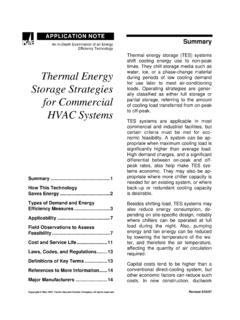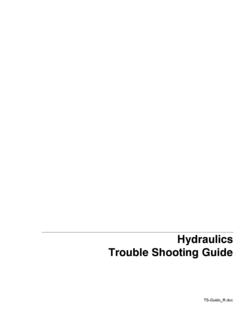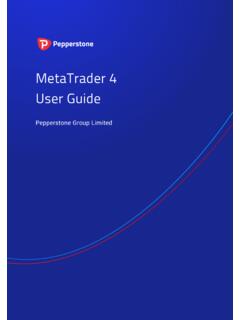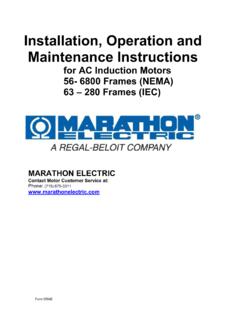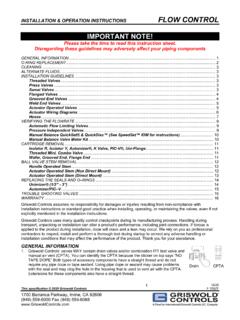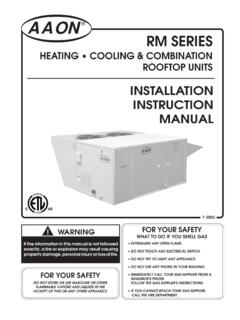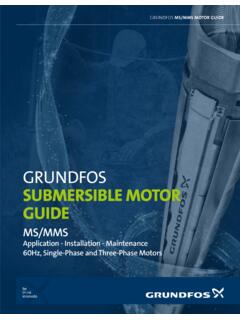Transcription of GE Panametrics Ultrasonic Flow Meter - Pacific Gas and ...
1 RPhysical installation Requirements and Pipe Preparation1. Install the transducers on a straight run of pipe free of valves, flanges or elbows. To measure accurately, this run of pipe must be at least 15 pipe diameters in length. 2. Locate the transducers so that there is a length of at least 10 pipe diameters of straight, undisturbed pipe upstream from the point of measurement and 5 pipe diameters of straight, undisturbed pipe downstream from the point of measurement. See Figure 1. Page 1 of 9 Application NoteGE Panametrics Ultrasonic Flow MeterTransducer InstallationPart II3. The transducers can be installed on a horizontal run of pipe or a vertical run of pipe with flow going up. Avoid installing transducers on a vertical run of pipe with flow going down unless it is known that the pipe will always be full. In this configuration, intermittent flow will usually prevent establishment of a steady Ultrasonic signal.
2 4. Prepare the pipe. On the section of pipe where the clamping fixture, rails and transducers will be installed cut back the insulation, remove any loose paint, clean the pipe and sand off any corrosion or rough spots. If the pipe is extremely rough the Ultrasonic signal will be scattered by the rough surface and will not be received by the flow Meter , preventing flow measurement. ABCF igure 2: Transducers installed on 2 of 9 Figure 3: Transducer clamp setup. A) Insert the un-indexed rail into the slots on the clamping fixtures located opposite the chain hooks. Then insert the indexed rail into the slots on the opposite side of the ) Line up the zero end of the indexed rail exactly with the outside edge of one of the clamping ) Move the other clamping fixture along the indexed rail so that the inside edge of the fixture lines up with the value on the rail that matches the transducer spacing value.
3 In this image the transducer spacing value is #402 Transducers on Pipes Greater than 2 in DiameterFor pipes larger than 2 in diameter, #402 transducers are usually used. In this case, the two transducers are clamped to the pipe using a clamping mechanism as shown in Figure 2. The mechanism consists of two clamps connected by a pair of rails and secured to the pipe using chains and threaded Before installation , make note of the Transducer Spacing value calculated by the PT878 on the Path tab, as described in Part I of this Application Slide the un-indexed rail into the slots on the two clamping fixtures located opposite the chain hooks, as shown in Figure 3A. 3. Slide the indexed rail into the slots on the two clamping fixtures located close to the chain hooks. Line the zero end of the indexed rail up exactly with the outside edge of one of the clamping fixtures, as shown in Figure 3B.
4 Tighten the red screws on the marked and unmarked rails on this clamping Slide the other clamping fixture along the indexed rail so that the inside edge of the fixture is lined up with the value on the rail that matches the Transducer Spacing value. See Figure Tighten the remaining red screws on the clamping fixtures to secure it to the 4: Transducer placement on horizontal pipe 3 of 9 Figure 5: Installing transducer clamps and transducers. A) Wrap each chain around the pipe. B) Attach chain to threaded hook. C) Tighten wing nut to hold clamping fixture in place. Hand tighten only! D) Insert transducers into clamping fixtures to make sure they will fit. Make adjustments as needed and remove transducers. E) Add a thick ridge of couplant to transducers. Reinsert transducers into the appropriate clamping fixture. Tighten set screws firmly with the set screws located in the center of each clamping fixture.
5 Hand tighten only!Table 1: Ultrasonic Couplants6. See Figure 4. For horizontal pipe runs, transducers should be placed within a cone 30 above and 30 below the horizontal axis of pipe to avoid signal interference from air and Prepare the pipe in the areas that the transducers are to be installed as described in the Physical installation Requirements and Pipe Preparation section above. 8. Install the clamping fixtures by wrapping each chain around the pipe and attaching it to the threaded hook. Tighten wing nuts to hold fixtures in place. Hand tighten only! See Figure 5A, 5B, and Note that the transducers must be placed so that their coaxial cable connectors point away from each other, as shown in Figure 2 and Figure 5E. 10. Insert the transducers into the clamping fixtures to make sure they will fit between the set screws and the pipe.
6 Adjust the set screws so that couplant will not be scraped off the transducers when they are inserted. Remove the transducers. 11. Spread a thick ridge of silicon grease across the center of the transducer along the line where it will contact the pipe. Reinsert the transducer into the appropriate clamping fixture. Use CPL-1 silicon grease for general applications below 150F and G-9030 silicon grease for higher temperature Replace transducer under set screw and tighten firmly with the large bolts located in the center of the clamping fixture. Hand tighten only! See Figure 5E. CouplantTemp RangeCPL-1G-9030-40 - 150 F(-40 - 66 C)-40 - 445 F(-40 - 230 C) Direction of FlowUpstream Transducer with RED Cable Sleeve. Downstream Transducer with BLUE Cable Sleeve. Page 4 of 9 Figure 6: Identifying upstream and downstream cables.
7 Note that the upstream transducer cable connector has a RED cable sleeve and the downstream transducer cable connector has a BLUE cable sleeve. On the Meter -end of the cables, the connectors with the same color cable sleeves must be attached to corresponding upstream and downstream jacks on the TP878 Meter . 13. Repeat steps 11 and 12 for the second Attach the cables to the transducers. Make note of the color of the cable sleeve that is attached to the upstream transducer and the downstream transducer. See Figure 6. 15. Proceed to Attaching Cables to Meter section on page 6 of this Application NoteFigure 8: Small-pipe Transducers installed on pipe. Page 5 of 9 Installing #24 Transducers on Pipes 2 in Diameter or LessSee Figure 8. To measure flow in small pipes, #24 or #407 transducer sets are usually used. This section describes the use of #24 transducer sets.
8 In these sets, the transducers are part of a unit that includes the transducers, a black metal bracket and mounting straps. The transducers are attached to a pipe with hook-and-loop Before installation , make note of the Transducer Spacing value calculated by the PT878 on the Path tab, as described in Part I of this Application Note. 2. Loosen the set-screw of the movable transducer and slide it until the left edge of the position indicator is lined up with the value on the indexed bracket that matches the Transducer Spacing value, as shown in Figure 9. 3. Spread a thick ridge of silicon grease across the center of each transducer Use CPL-1 silicon grease for general applications below 150F and G-9030 silicon grease for higher temperature applications. See Table 1 for specific temperature See Figure 4. For horizontal pipe runs, transducers should be placed within a cone 30 above and 30 below the horizontal axis of pipe to avoid signal interference from air and Hold the transducer bracket close to the pipe in an appropriate location.
9 Bring the hook-and-loop straps around the pipe a thread each one through its corresponding slot, as shown in Figure Push the transducers and bracket against the pipe, tighten the straps and lock the transducer unit in place by adhering the hook and loop surfaces of the straps. IR PortPower PortInput/Output PortDownstream Transducer Port Upstream Transducer Port Page 6 of 9 Figure 7: PT878 ports. The upstream transducer port is closer to the outside edge of the Meter . The downstream transducer port is adjacent to the upstream port. Use the cable sleeve colors to assure that the transducer cables connect the downstream and downstream ports to the corresponding #407 Transducers#407 transducers can be used with pipes from 1/2 to 4 in diameter. Their configuration is similar to that of #24 transducers, such that the instructions for installing #24 transducers can be used as a guide for the # pipes of less than 1 in diameter, if the signal strength from the #407 transducers is higher than 70, use four (4) or more traverses to reduce the signal.
10 Attaching Cables to Meter1. Once cables are attached to the transducers, attach the other ends of the transducer cables to the PT878 Meter . Make sure that the cable connected to the upstream transducer (usually indicated by the red cuff) is inserted into the transducer cable port closer to the outside edge of the Meter . Make sure the cable connected to the downstream transducer (usually indicated by the blue cuff) is inserted into the adjacent port. See Figure After the Meter settles, a reasonable flow reading should be displayed on the Meter . If there is a flashing Error Code Message (the letter E followed by a number flashing in the main screen s System Tray) refer to the diagnostics section of this Application Transducers 1. Remove the Ultrasonic transducers before removing the clamps and rails to reduce the risk of dropping and damaging the transducer connectors.







